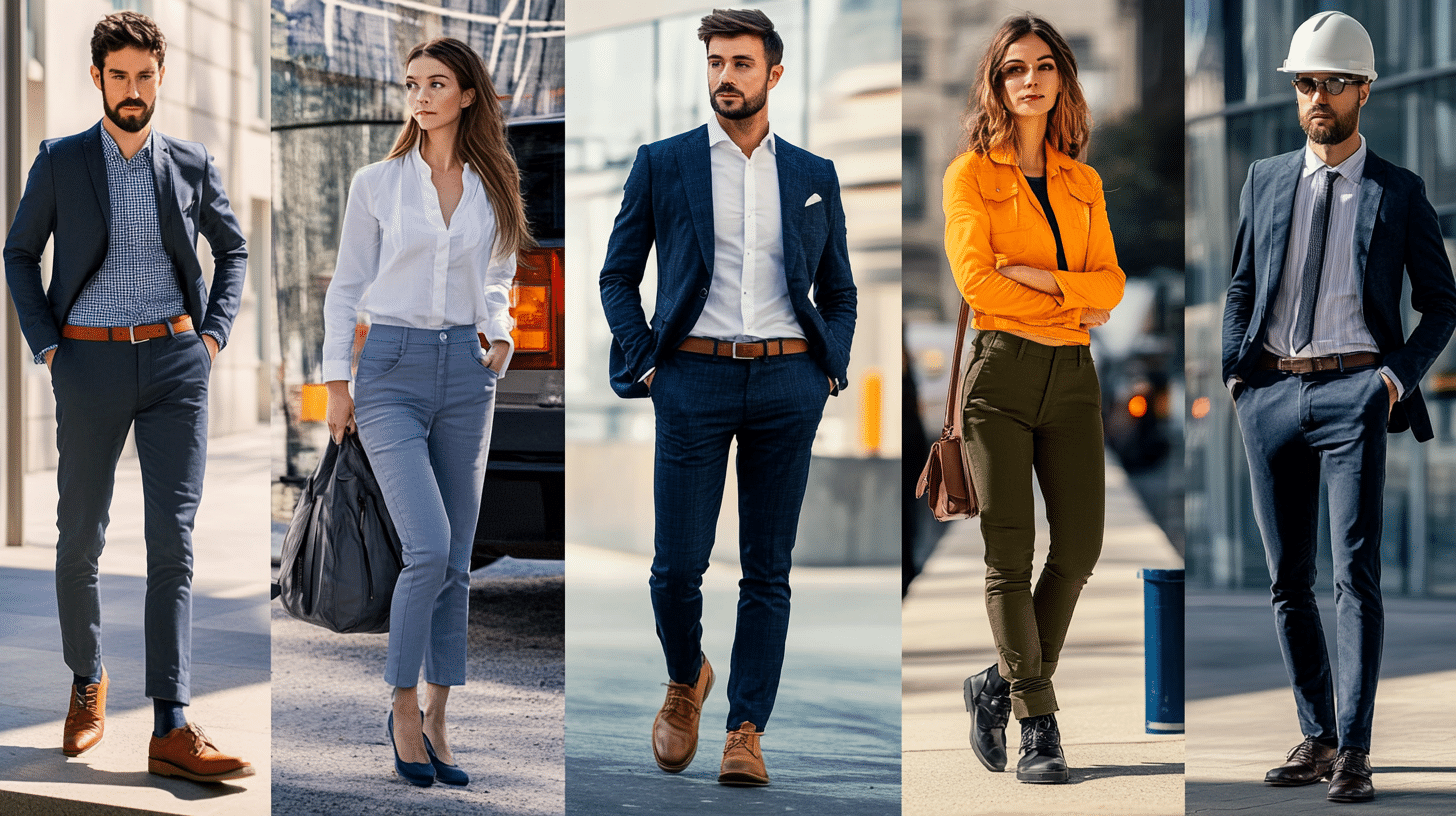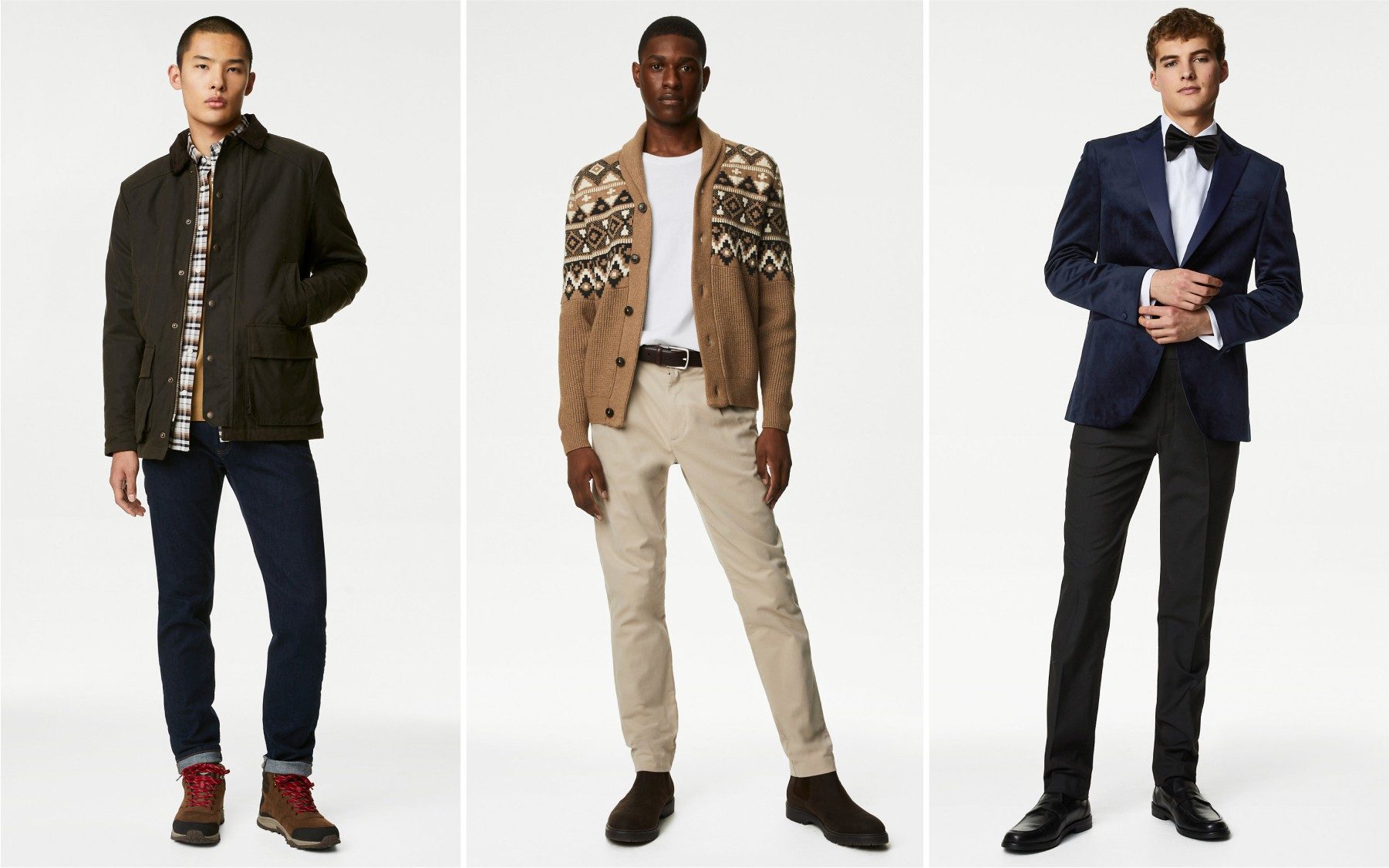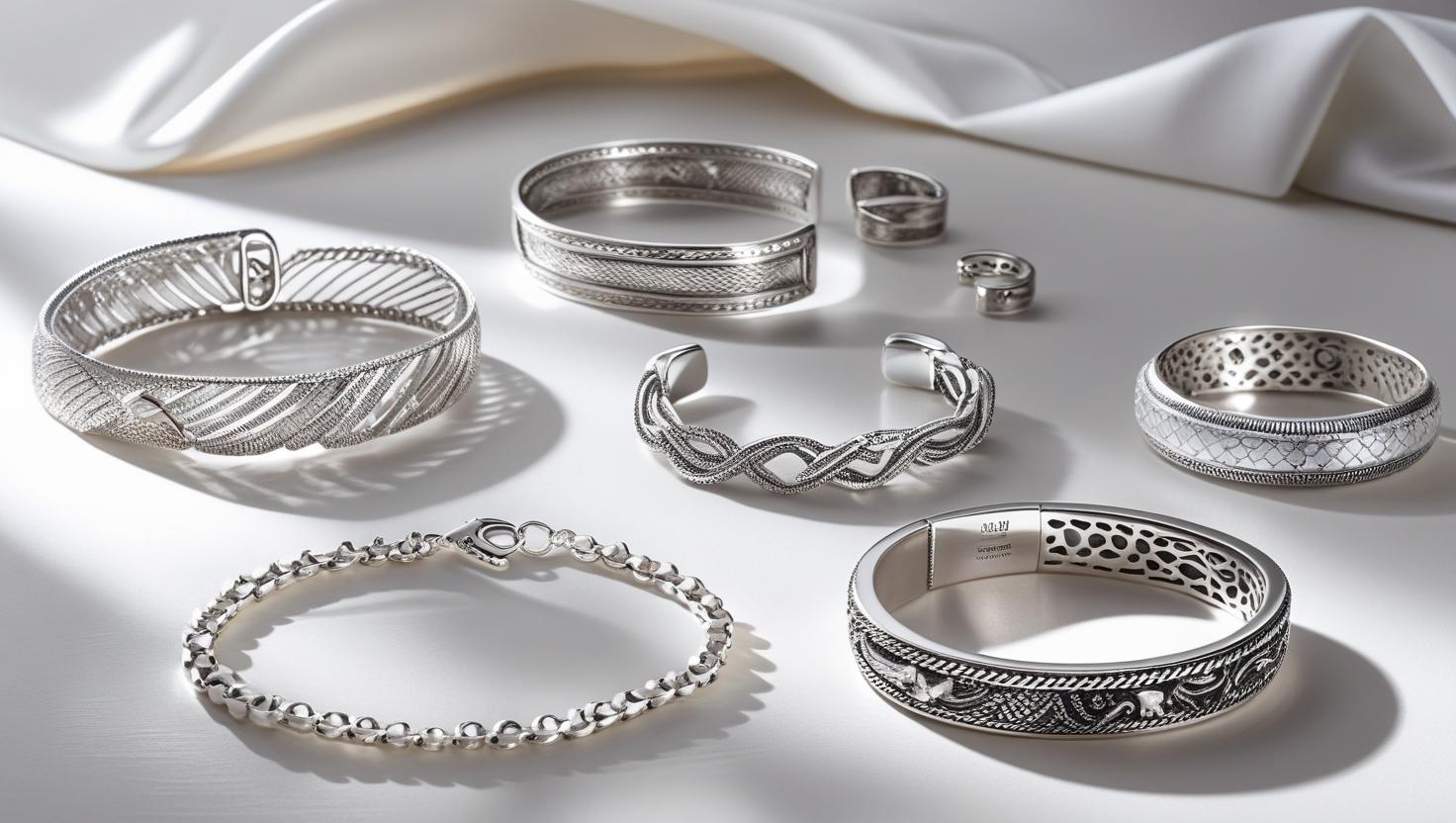What Do Architects Wear: Comfortable & Professional Attire
Welcome to our guide on what architects wear in their professional lives. Your clothing choices matter as a designer in the built environment.
They reflect your attention to detail and practical needs.
This blog discusses the everyday wardrobe decisions architects make, from comfortable studio wear to professional client meeting attire.
We’ll cover seasonal considerations, appropriate footwear, site visit necessities, and how different office cultures shape dress codes.
If you’re a student preparing for your first job or a seasoned professional looking to refresh your work wardrobe.
Then this practical guide will help you dress appropriately for every aspect of architectural practice.
What o Architects Wear Daily
General Dress Code Overview
Most architectural offices follow a business casual dress code.
This typically means neat, professional clothing without being overly formal.
Architects often need to balance looking professional for client meetings while also being comfortable enough to visit construction sites or spend long hours at a computer.
Well-fitted slacks or chinos, button-down shirts, blouses, simple dresses, and clean, quality shoes are common everyday choices.
Understanding Dress Code Based on Office or Job Site
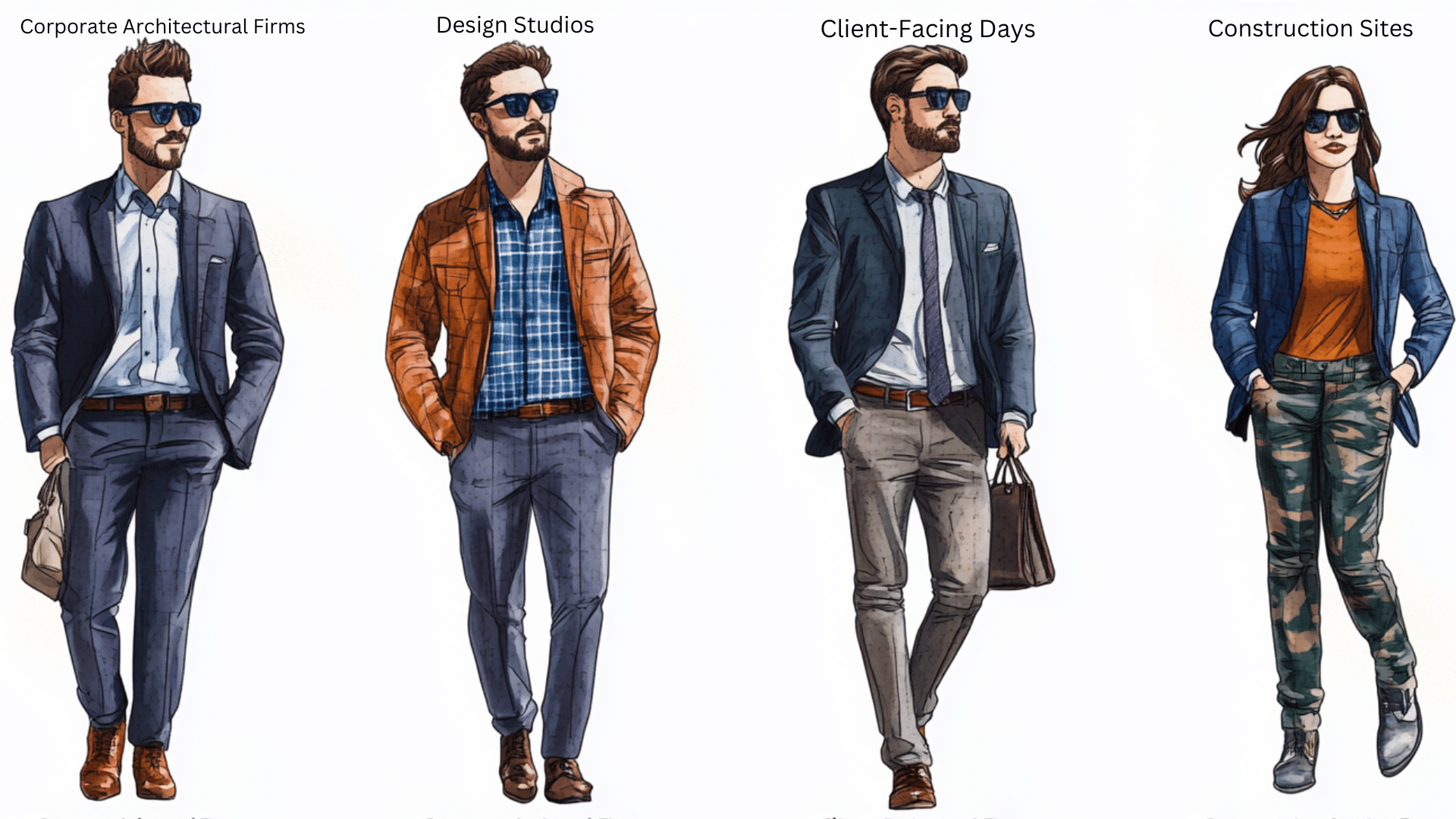
The appropriate attire varies significantly depending on your work environment:
- Design Studios: Often more creative and relaxed, allowing for more personal expression through clothing
- Corporate Architectural Firms: Typically more conservative, especially if working with corporate clients
- Construction Sites: Require protective gear, including hard hats, steel-toed boots, and weather-appropriate clothing
- Client-Facing Days: Call for more polished attire than days spent solely at your desk
Pay attention to what senior architects wear, especially those in positions you aspire to reach.
Different cities and regions may also have different expectations – architecture firms in New York or London might be more formal than those in Austin or Barcelona.
Dress Code for Formal Settings

When attending important meetings, presentations, or conferences, architects should elevate their attire:
- Client Presentations: Well-tailored suits or dress pants with blazers, conservative dresses or skirts with blazers
- Conferences: Professional attire that represents your firm well
- Award Ceremonies: Often call for formal business attire or cocktail attire
- Networking Events: Business casual that leans toward the more polished end of the spectrum
Attention to detail matters in formal settings. Well-maintained shoes, minimal and tasteful accessories, and clean, pressed clothing communicate professionalism.
Many architects opt for simple, quality pieces in neutral colors (black, gray, navy) that reflect the clean lines and thoughtful design they create in their work.
On-Site Attire: Style with Safety
It’s important to wear clothes keeping in mind professionalism and different conditions.
Essential Safety Gear for Construction Sites
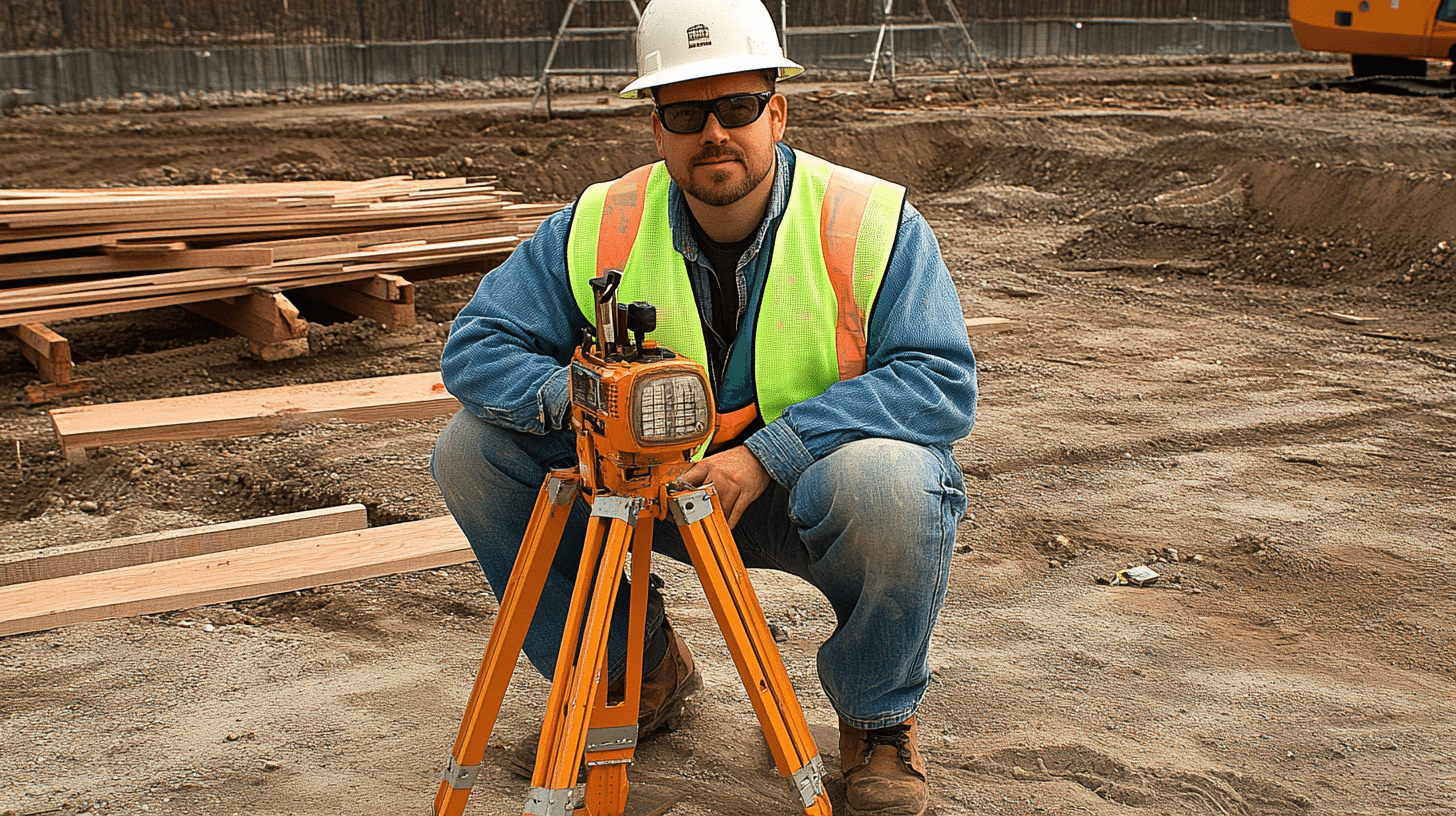
When visiting construction sites, safety must come first in your clothing choices.
Start with a properly fitted hard hat—not just any hat, but one that meets safety standards. Steel-toed boots are non-negotiable to protect your feet from falling objects and sharp objects.
A high-visibility vest helps workers spot you, especially around heavy machinery. Wear safety glasses to protect your eyes from dust and debris.
Many designers add a professional touch with a clean, fitted work jacket that has multiple pockets for tools, notebooks, and measuring devices.
This practical approach keeps you safe while maintaining your professional image.
Weather-Appropriate Professional Clothing
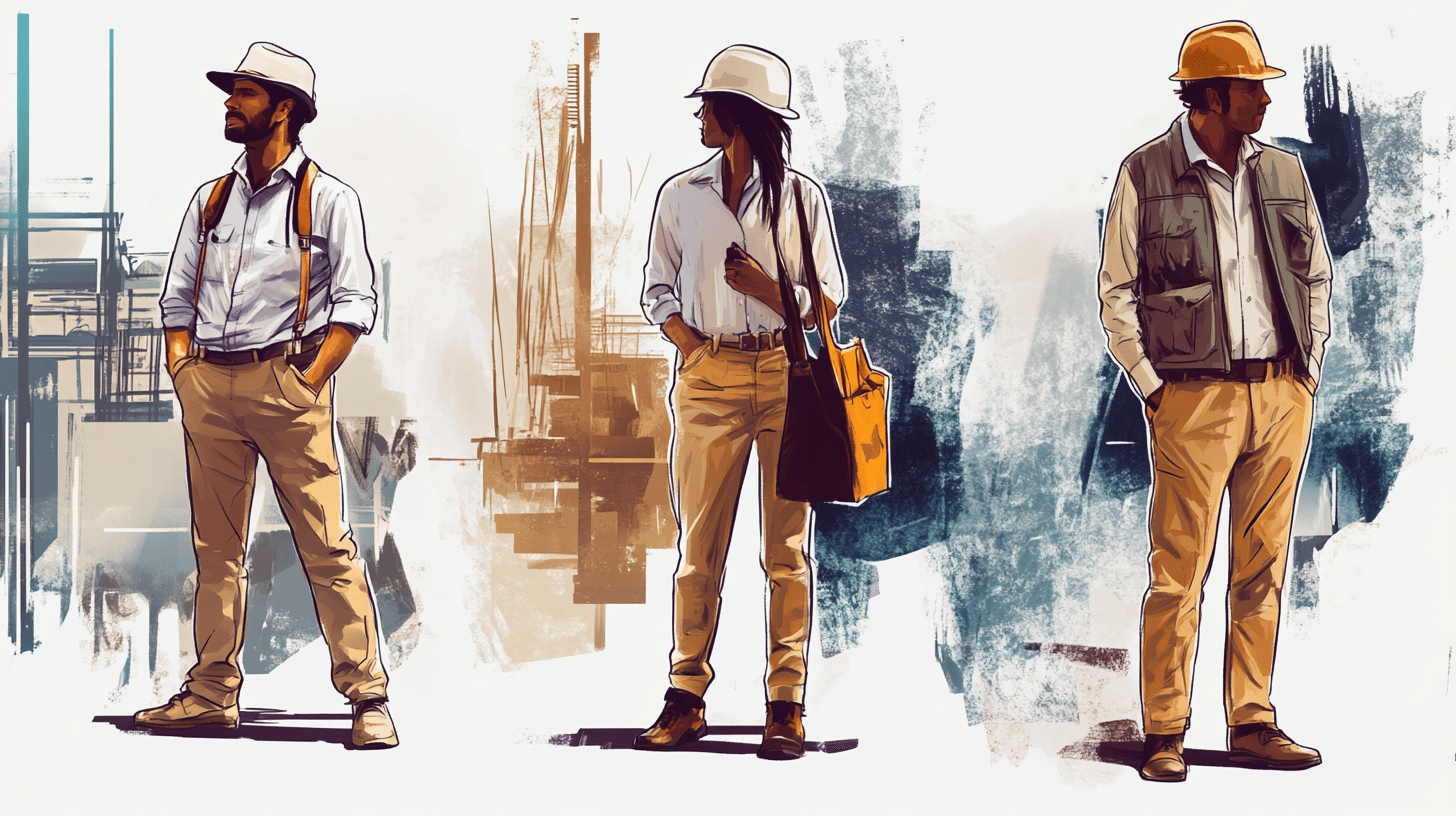
Dressing for site visits means planning for weather conditions while still looking professional.
In summer, choose lightweight, breathable fabrics that resist wrinkles – cotton chinos and short-sleeve button-ups work well.
Add a sun hat and sunscreen for outdoor protection. For winter sites, layer with thermal base layers under regular work clothes, and bring a warm but professional-looking coat.
Waterproof clothing is essential for rainy days. A good rain jacket and water-resistant pants will keep you dry without making you look like you’re going fishing.
Always check the weather forecast before heading to a site, and keep a change of clothes in your car or office for unexpected conditions.
Outfit Choices for Architects
Casual and Comfortable Options for Daily Work
Architects spend long hours sketching, modeling, and designing, so comfort matters.
Dark jeans paired with collared shirts or knit tops work well in many firms.
Khakis or chinos offer a step up in formality while staying practical.
Quality t-shirts under blazers create a smart-casual look appropriate for design studios and creative offices.
Suits and Formal Attire for Client Meetings
Architects should appear polished and professional when meeting clients or presenting designs. A well-fitted navy, charcoal, or black suit is a versatile option.
Some architects opt for distinctive ties or pocket squares to express creativity while maintaining professionalism.
For women, tailored pantsuits or blazers with dress pants work excellently.
Female Architect Attire
Women in architecture balance professionalism with practicality through pencil skirts with blouses, shift dresses, or tailored pants with silk tops.
Blazers add polish to any outfit and work well over dresses or pants.
Comfortable yet professional footwear is crucial, as site visits may arise unexpectedly. Subtle accessories complement rather than distract.
Seasonal Considerations in Attire
Winter calls for layered clothing with quality sweaters or cardigans over button-downs. Wool coats provide warmth while maintaining professionalism.
Summer requires breathable fabrics like cotton and linen, especially for hot site visits.
Spring and fall benefit from versatile pieces like lightweight jackets that adapt to changing temperatures.
Footwear and Essential Accessories
When we talk about outfits, how can we miss out on footwear and essential accessories?
Recommended Shoes for Both Office and Job Sites
Architects need versatile footwear that transitions between boardrooms and building sites.
Leather loafers or oxfords work well for office days, while sturdy Chelsea boots can handle both settings.
For women, flats or low heels with good support are practical choices. Steel-toed boots should always be accessible for construction visits.
Key Accessories and Their Role in Professionalism
A quality leather belt coordinates with your shoes and ties your look together.
Briefcases or structured laptop bags protect your tools while making a professional statement.
Ties and scarves add color to neutral wardrobes and can be removed for site visits. Consider a distinctive watch that balances functionality with style.
Jewelry Tips for Architects
Keep jewelry minimal and meaningful. Simple stud earrings, a classic watch, and perhaps one statement piece work well.
Avoid dangling items that might interfere with drawing or model-making.
Many architects choose architectural or geometric pieces that reflect their design sensibilities without becoming distracting during professional interactions.
Comfortable Clothing for Site Visits
Its important to carry clothes that are comfy and durable for different weather and site visits.
Protective Gear for Site Visits
Safety comes first on construction sites. Always bring your hard hat, which is often required by law. Steel-toed boots protect your feet from falling objects and hazards.
High-visibility vests or jackets ensure workers can see you, especially around heavy machinery.
Many firms provide personal protective equipment, but having your own ensures a proper fit.
Practical, Comfortable Clothing for Job Site Visits
Durable pants like jeans or work khakis resist tears and dirt while allowing movement when climbing ladders or navigating unfinished spaces.
Layer tops so you can adjust to indoor/outdoor temperature changes. Avoid loose clothing that might catch on protruding objects.
Pockets are valuable for carrying measuring tools and notebooks.
Weather Considerations and How to Dress Accordingly
Rain requires waterproof jackets and water-resistant footwear to stay comfortable during inspections—summer heat calls for lightweight, breathable fabrics and sun protection, including hats.
Winter demands insulated layers, thermal socks, and gloves that still allow dexterity for taking notes or examining details. Always check weather forecasts before site visits.
Functional and Comfortable Designer Clothing
Current Fashion Trends Among Designers
Design professionals today often embrace a minimalist approach to workwear with clean lines and monochromatic color schemes.
Black remains a staple, but deep blues, grays, and earth tones have gained popularity.
Japanese-inspired clothing with structured yet flowing silhouettes has influenced many in the field.
Technical fabrics that look professional while offering comfort and mobility have become increasingly common.
Sustainable and locally-made clothing aligns with growing environmental awareness in the design community.
Creative Ways to Integrate Style into Professional Attire
Many design professionals express creativity through thoughtful details rather than flashy statements.
Bold eyeglasses have become a signature accessory for many. Simple, well-made jewelry with geometric shapes or architectural references adds personal flair.
Patterned socks or unique linings inside jackets offer subtle personality. Handmade or limited-production items showcase an appreciation for craftsmanship.
Some professionals use bags or portfolios from innovative designers as functional statement pieces.
The Shift Towards Comfortable Workwear
The design field has moved toward clothing that accommodates long hours at drawing boards, computers, and construction sites.
Stretch fabrics that maintain a structured look while allowing movement has replaced stiff formal wear.
Layering has become essential for adapting to various work environments throughout the day.
Shoes with proper support The post-pandemic workplace has further normalized comfortable yet professional attire that functions well for both remote collaboration and in-person meetings.
Conclusion
Dressing as an architect requires a thoughtful balance between professionalism, comfort, and practicality.
Your clothing should allow you to move from the drawing desk to the client meeting to the construction site, often in a single day.
While dress codes vary between firms, most architects find that quality basics in neutral colors serve them well, with accessories offering opportunities for personal expression.
As the field changes, comfort has become increasingly important, with technical fabrics and adaptable pieces gaining popularity.
Remember that your appearance communicates your design sensibility and attention to detail – important qualities in the architectural profession where both form and function matter.

